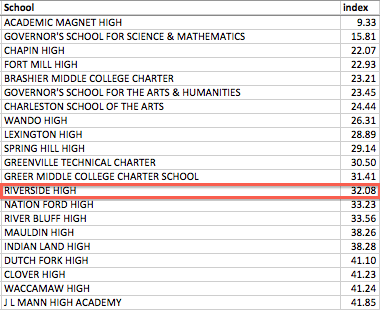FROM CRENSHAW TO HARTSVILLE: RACE, POVERTY, AND EDUCATION REFORM
In order to avoid the existential hell known as I-85 where morning commuters creep along bug-like in a daily Kafkan nightmare, I take winding backroads through the Upstate of South Carolina to my university.
Recently, I noticed a real estate sign advertising a new neighborhood with an added bright yellow sign above signaling, “RIVERSIDE SCHOOLS.”
Children in this housing development will attend, eventually, Riverside High, which is ranked 13th lowest of 237 SC high schools in the 2014 Poverty Index, has Excellent/Excellent ratings on the 2014 SC report card, and tests only 51/341 students on subsidized meals and 25/341 with limited English proficiency:
 Having placed student teachers at Riverside High, and knowing faculty there, I can attest that this is a wonderful school, and students are both supported and challenged.
Having placed student teachers at Riverside High, and knowing faculty there, I can attest that this is a wonderful school, and students are both supported and challenged.
The real estate sign struck me especially since I had viewed two new educational documentaries: Crenshaw, a film by activist Lena Jackson on the Los Angeles school, and 180 Days: Hartsville, focusing on two schools—Thornwell School for the Arts and West Hartsville Elementary School—along the infamous I-95 Corridor of Shame in my home state of SC.
While nearly 2500 miles apart and politically/culturally worlds apart, Los Angeles and Hartsville reflect powerful narratives about the intersections of race, poverty, and education reform. As well, they offer nuance to those intersections since Creshaw High is high-poverty, majority-minority in an urban setting while Hartsville’s elementary schools are high-poverty, majority-minorty in the rural South.
Before discussing each documentary separately, let me highlight what they share as entry points into reconsidering race, poverty, and education reform:
- Public schools both serve and reflect the communities within which they sit.
- Race and poverty significantly impact academic achievement, and thus, when schools, teachers, and students are labeled, ranked, and judged by test scores, high-poverty and majority-minority schools are disproportionately identified as “failing.”
- Political leadership often expresses support for education and public schools, but implements policies that appear tone deaf to the communities they represent.
- Education reform advocates ignore the failure of popular policies.
- Demands of effort and not embracing excuses dominate political and educational rhetoric (despite ample evidence that effort is trumped by racism/classism).
- Parents, students, and teachers are often passionate about education, regardless of economic status or race.
Crenshaw: Disenfranchising through Take Over Strategies
Crenshaw is, as David B. Cohen explains, a “cautionary tale” about school take overs narrowly and education reform From Crenshaw to Hartsville: Race, Poverty, and Education Reform | the becoming radical:


